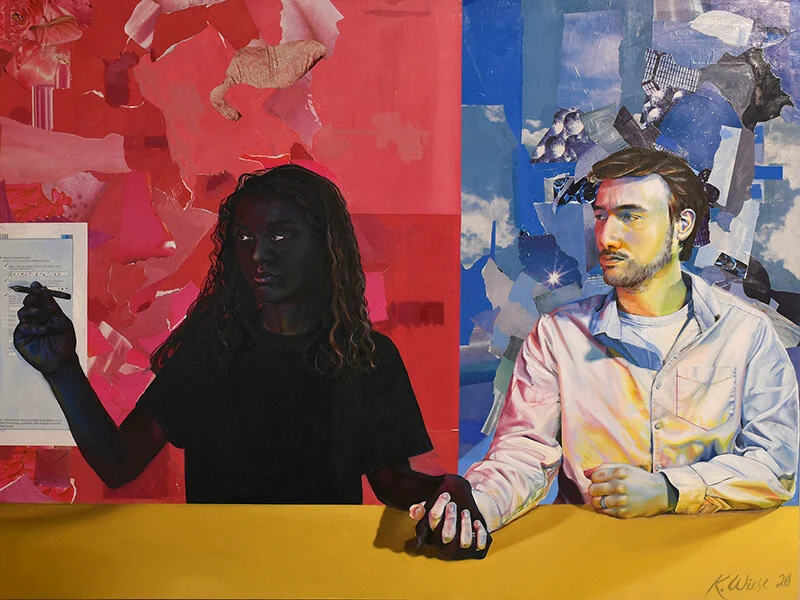Artist Katharen Wiese: Permission to Own It
Art can reflect life in a profound way. When you see a painting like “if a black woman is afraid of the dark is she afraid of a shadow or herself” you know it has a story behind it. There is a Black woman sitting on a pink stool. There is a pink easel behind her with a painting of the same Black woman with a much darker skin tone. You can’t conceive of the concept without a lived experience of colorism, womanhood, and personal identity. The artist of this amazing painting Katharen Wiese talked with Studio Noize about her life and her artwork.
Katharen Wiese (Photo by Devon Coulson)
Kat Wiese is an artist, curator, and community arts organizer living and working in Lincoln, Nebraska. She’s graduated with her B.F.A. in Studio Art from The University of Nebraska at Lincoln in 2018. Her education in the world of race began at a much earlier age. Her mother is Black and her father is white. This multicultural upbringing led Kat to question some things about herself at an early age.
“When I was four or five, I would look around and I thought, well, my mom doesn't look like me. Because my mom's much darker than me.” Kat says. “It's stupid but comparing myself to my mom and thinking, well she can't be my mom because I look different. And when I look at commercials and I look at these different places, there are no interracial couples.” (10:18)
Kat carried this conflicting idea between appearance and race with her through middle school and high school. Various experiences like being question by other girls asking “What are you?”. Witness her mother being treated differently because she was Black. She admits to internalizing white ideals of beauty like having long straight hair (she loves her ow hair now by the way). She has dealt with different stereotypes of Blackness and found herself relating to other Black and biracial girls through the years. Along the way she developed a strong sense of who she is as a multicultural person.
Painting
“if a black woman is afraid of the dark is she afraid of a shadow or herself” by Katharen Wiese
“if a black woman is afraid of the dark is she afraid of a shadow or herself” became something of a summary of her life. It is a six and a half foot by seven-foot piece. It is a quasi-self portrait using a model friend of hers named Sydney, who is also biracial, as a representative stand-in. The piece explores the relationship between what she sees as her privilege as a light-skinned woman and the ways in which dark-skinned women, like her mother, have been pushed to the background.
The backdrop was made of brown paper bags in a nod to the infamous brown paper bag test that was used to divide Black people by color. It was assumed that if you were lighter than the paper bag you were better and acceptable. Being darker than the paper bag meant you were less valuable and not as desirable. There is a panel behind the backdrop of images from magazines of women that failed the test.
“This choice that lighter-skinned people have the privilege of making about how they're going to exist and present themselves in the world. And there's pressure to pass. There's pressure to present in certain ways, and so the way that you choose to present yourself can be a form of like pushing against oppressive systems that tell you the things that are black about you are not beautiful. And so the choice to make the figure hyper black, a nod to Kerry James Marshall.”
The College Experience
“I think there was definitely a period in time like, so that happened in late high school and early in college, I was over performing my blackness. And then like I remember my mom told me, I want to say something like you don't have to like, wear yourself like that. She just like brought me she just brought me to the ground in a good way, like grounded me.”
Finding herself in a predominantly white institution like the University of Nebraska at Lincoln was a challenge for Kat. She had to adjust to the ways in which PWIs don’t seek to openly accept Blackness. Whether it is the lack of critique from her fellow students or interest in engaging with her work which prominently features issues around racial identity. One of the great things about Kat is the way that she seeks out other people to build a community to nurture each other. She made the choice to not just tossed out other artists like her but to participate in actively creating a space for them. She worked with her friend Vernée Norman to run Parallel Visions, a space in downtown Lincoln that was focused on artists and communities of color. They all volunteered to run the space. No one got paid. They did manage to have nine months of shows that showcased their culture without the focus of the white gaze.
“No one went out and told us to do that. But we had to make space for ourselves in Lincoln and in the art community where so often the work being shown and the people putting up the shows don't look like us. And so we were like, we're going to do this like for ourselves and carve out this space.” (48:20)
Like Barkley
Barkley Hendricks is one of Kat’s big influences, along with Kerry James Marshall. You can see her careful study of Black figuration and the use of metaphor in clothing and color.
“There's a really huge, wonderful painting in the Sheldon Museum, which is like a university museum at UNL, and they have an eight-foot painting called “Bid ‘Em In/Slave” of Barkley's friend Angie, and she's so cool she's like a pink backdrop. And then she has her arms folded over her chest and the words slave on her shirt and she and she could not be in more ownership of herself. And so this image was so powerful to me.”
Kat has been painting since she was 12. Amazingly she did not use oil paint until she got to college. Like most high schools they didn’t allow the student to use the solvents on school property. She found herself painting with acrylics and struggling to do all the things oil paint does naturally.
“I wasn't allowed to use oil paint at school, which was where I was making what I was making at the time. So I was doing a lot of blending and rendering and like thinking about light and doing all this like technical type stuff. My very last year in high school and then I got to college and I was using oil paint and all these things I was trying to achieve in acrylic were suddenly so easy because it wasn't drying instantly. So that was a huge turning point. And yeah, I was like, oh, well, this is how people are doing this.” (55:56)
Our Favorite Was Yellow
Another wonderful painting from Kat is a much more personal piece called “Of the boxes we filled our favorite was yellow”. This piece features Kat and her husband in a pose referencing the Lovings’ press conference in 1967 after the Supreme Court ruled that laws banning interracial marriage were unconstitutional. Kat has known her husband since they were babies and the piece is filled with allusions to their childhood. Kat is shown as herself still with the hyper black skin from “if a black woman..” Kat says the color has a different meaning in this context.
“When I was in elementary school like I said, I went to a virtually like an all-white school and was one of like 10 kids out of like over a thousand that were students of color. And so all the teachers were white. And I remember filling out a demographic form, and I'm Native American, white and African-American. And my teacher, I was like, I'm all these things and I can only pick one, like, what am I supposed to do? She was like Just like just pick black. I was like, OK, I went along with it. But I was also thinking like, well, like, why can't I claim all that I am right?” (55:56)
Despite some strong narrative elements like the census form collaged into the background and the color yellow (both her and her husband's favorite color) Kat says she can say that she doesn’t all the way understand exactly what she is trying to say yet. Like most artists, the true understanding only comes after the work is done and this one is very much in the process. She wants to redo this one and add more layers of meaning.
“I want to remake that piece because I want to make it bigger because that one's not to scale. And then I'm thinking about making major changes to it. But it was an experiment in some ways of exploring that content.” (58:28)
In another year or so Kat has a wide range of options she might look into exploring. You might catch her at Yale, following in the steps of Barkley Hendricks, or on the streets of Chicago learning from street artists. It’s no doubt this talented young woman has the passion and drive to succeed in the art world.
Follow Katharen Wiese: www.katwiese.com + @katharen.wiese
Listen to the full interview on Studio Noize Episode 97















